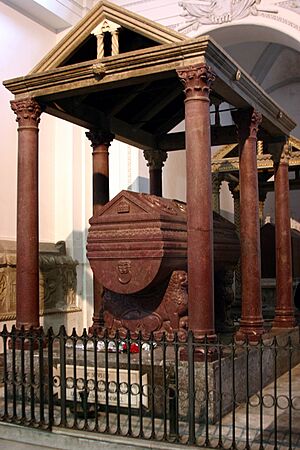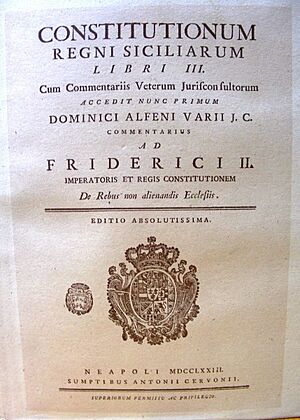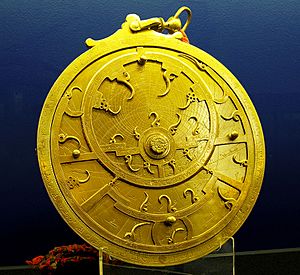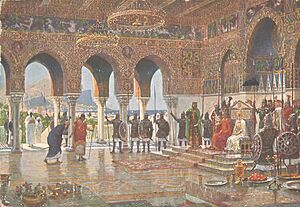History of Swabian Sicily facts for kids
Swabian Sicily was a special time in the history of Sicily. It was when the Hohenstaufen family ruled the island. This period lasted from 1194, when Henry VI became king, until 1266. That's when Manfred of Sicily was defeated by Charles I of Anjou.
Contents
History of Swabian Sicily
Henry VI and Frederick II's Rule
In 1194, William III of Sicily was removed from power. His great-aunt, Constance of Altaville, became queen. She had married Henry VI, who was the son of Frederick Barbarossa.
Henry VI died in 1197. His wife, Constance, ruled Sicily alone for about a year. Before she passed away, she made sure their four-year-old son, Frederick II, was crowned king. This started the new Hohenstaufen family rule in Sicily.
Constance then acted as a regent for Frederick. A regent is someone who rules for a king or queen who is too young. After Constance died in 1198, pope Innocent III became Frederick's guardian. The Pope recognized Frederick as the rightful heir to Sicily's throne.
From 1201 to 1206, Markward von Annweiler was regent. Then William of Capparone took over. Frederick became old enough to rule on his own in 1208, when he was fourteen.
Palermo, the capital, became a very important city. It was the center of the Holy Roman Empire, which included parts of Italy. This is where the Sicilian School of poetry began. It was the first truly Italian style of poetry.
Frederick himself was called the 'stupor mundi', meaning "marvel of the world." People said he was like an early Renaissance prince. In 1231, he created important laws called the Constitutions of Melfi. From 1220 to 1239, he moved the remaining Muslim people from Sicily to other areas.
Frederick's reign was often filled with conflicts. He struggled with the Pope and with many towns in mainland Italy. He had both victories and made compromises. For example, he took back Syracuse in 1221, which had been held by Genoa.
The nobles in Catania rebelled against him in 1232. Many stories came from this conflict. One legend says Frederick built Castello Ursino in Catania to control the city. Frederick made Catania directly part of his kingdom.
He chose Castrogiovanni (now Enna) as his summer home. He made its city walls stronger with twenty towers. He also built a new palace and a chapel there. This is where he held the Sicilian Parliament. Today, the 'Torre di Federico II' still stands in Enna. Parts of Frederick's octagonal tower also remain in Augusta.
Frederick built palaces for himself and his wife in Augusta. He also helped organize the Fourth Crusade. He added many castles and strongholds across Sicily and southern Italy. When he died suddenly in 1250, he was buried in Palermo Cathedral, as he wished.
Manfred of Sicily's Reign
In his will, Frederick left most of his lands and titles to his second son, Conrad IV. This included the thrones of the Empire, Sicily, and Jerusalem. To his other son, Manfred, Frederick left the Principality of Taranto and other smaller lands. He also made Manfred the 'luogotenenza' (lieutenant) of the Kingdom of Sicily.
In October 1251, Conrad traveled to Italy. He met with imperial officials there. In January 1252, he landed at Siponto. From there, he and Manfred worked to bring peace to the Kingdom. In 1253, they took back rebellious areas like Caserta and Acerra. They also conquered Capua and finally Naples in October.
Conrad died of malaria on May 21, 1254. There is no proof that Manfred poisoned him. After Conrad's death, the Pope became the guardian of Conrad's young son, Conradin.
However, the Pope did not like the Hohenstaufen family. He promised the Kingdom of Sicily to Edmund the Hunchback. But Manfred, who was very skilled in diplomacy like his father, made a deal with the Pope. This allowed the Pope's army to occupy the land but protected the rights of Conradin's family.
Still, Manfred did not feel safe from the Pope. So, he gathered a large army to fight the papal forces near Foggia. In 1257, Manfred defeated the Pope's army. He also put down rebellions within Sicily.
When a rumor spread that Conradin had died, Sicilian leaders asked Manfred to become king. He was crowned at Palermo Cathedral on August 10. But pope Alexander IV did not accept Manfred as the rightful king. He saw Manfred as someone who had taken the throne illegally.
Manfred's power grew, especially as he led the Ghibelline group in Italy. In 1262, he married his daughter, Constance, to Peter III of Aragon. This made him even stronger.
Eventually, Manfred was excommunicated by the Pope. This meant he was officially removed from the Church. Pope Urban IV then offered the Kingdom of Sicily to Charles I of Anjou. Charles was the brother of Louis IX of France.
Charles marched against Manfred. He soundly defeated Manfred at the Battle of Benevento on February 26, 1266. Two years later, Conradin himself tried to take back the Kingdom. But he was defeated at the Battle of Tagliacozzo and was executed.
After the Hohenstaufens
Manfred's daughter, Constance, claimed the Kingdom of Sicily in 1281. After an event called the Sicilian Vespers, she became queen of Sicily from 1282 to 1285. This united Sicily with her husband Peter's lands.
Peter was crowned King of Aragon in 1282. He stayed in Spain from 1283 until his death in 1285. Then, the Kingdom of Sicily went to his second son, James. James's mother helped him rule Sicily.
James stayed on the island until his older brother, Alfonso III of Aragon, died in 1291. James then became King of Aragon and returned to Spain. He left Peter's third son, Frederick, in charge of Sicily.
James made peace with France. He planned to give Sicily to Charles's son, Charles II. But the nobles of Sicily crowned Frederick as their king instead. This was finally confirmed by the 1302 Peace of Caltabellotta.
Culture During Swabian Rule
Poetry and Art
The Sicilian School was a group of writers and thinkers. It started around 1166 and became very important under Frederick II in the 13th century. Frederick II himself wrote a book about falconry called De arte venandi cum avibus.
This "school" wasn't a formal place of learning. It included poets like Giacomo da Lentini and Guido delle Colonne. They wrote lyric poetry in the local Sicilian language. This style of poetry led to the creation of the sonnet, a type of poem with 14 lines. Manfred also supported art and culture, just like his father.
Law and Government
The Hohenstaufen rulers continued the legal traditions started by earlier Norman kings. They kept the Assizes of Ariano from 1140. Important legal experts, like Pier della Vigna and Roffredo da Benevento, worked at their court.
The Hohenstaufens also improved the Magna Curia of the Kingdom of Sicily. This was the main government office and the highest court. In 1231, the Curia produced important legal texts like the Liber Augustalis and Constitutionum Regni Siciliarum.
Astronomy and Science
Theodore of Antioch came to Frederick II's court in 1230. He became the king's astrologer, fortune-teller, doctor, and science advisor. He took the place of Michael Scot, who had passed away.
Translation of Knowledge
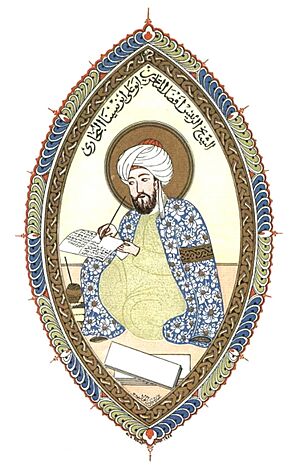
During this time, many important texts were translated. Scholars translated works from Arabic and Greek into Latin. This helped spread knowledge and new ideas across Europe.
|


